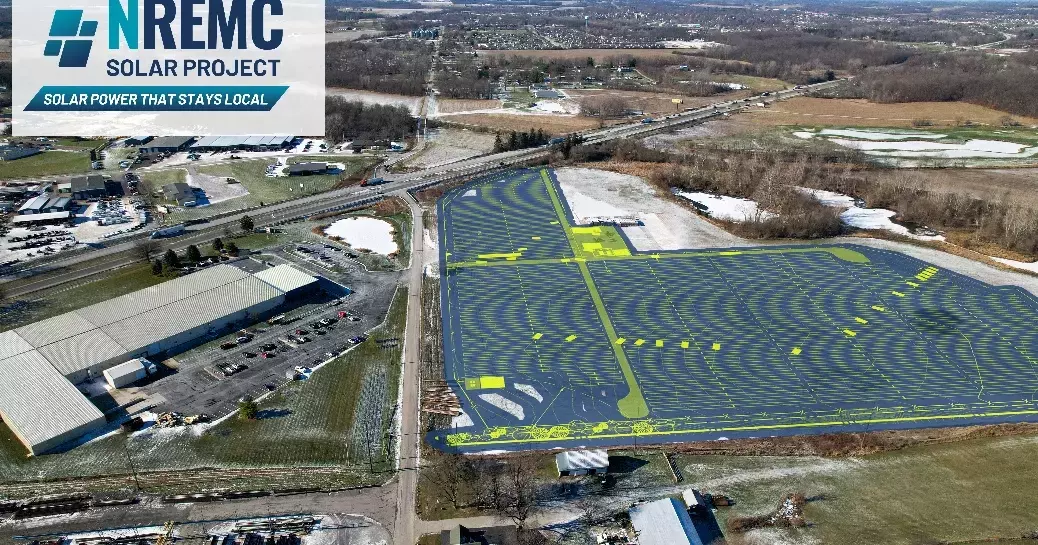
Key Features and Benefits
The Quarry Solar Project brings together multiple advantages. Firstly, the utilization of the former rock quarry land is a sustainable choice, repurposing an existing area for a crucial energy source. The generation of over 6,500 kW of power will have a significant impact on meeting the energy demands of Northeastern REMC. By combining power generation with agriculture, it creates a unique ecosystem where the sheep help in soil management while the solar panels generate electricity. This integrated approach not only benefits the environment but also ensures the long-term viability of the project. Additionally, the pollinator habitat and shade provided by the solar panels offer additional value by promoting crop health and biodiversity. It is a win-win situation that showcases the potential of renewable energy in combination with other industries.
The construction of the Quarry Solar Project at 100 South and U.S. 30 is a major step forward for Northeastern REMC. It demonstrates the cooperative's commitment to providing reliable and affordable electricity while also exploring innovative ways to integrate renewable energy into their operations. The expected completion by late spring 2025 gives a clear timeline for the project's realization, and the informational meeting on Dec. 19 provides an opportunity for the community to learn more and get involved. This project is set to be a game-changer in the region, setting an example for other areas to follow in their pursuit of sustainable energy solutions.
Power Generation and Cost Offset
The Quarry Solar Project is designed to play a crucial role in maintaining affordable electricity rates for Northeastern REMC. By generating a significant amount of power, it reduces the reliance on traditional energy sources and helps to offset costs. The solar panels will convert sunlight into electricity, providing a clean and renewable energy option. This not only benefits the customers of Northeastern REMC but also contributes to the overall sustainability of the region. The project's focus on cost offset ensures that the benefits of renewable energy are passed on to the consumers, making it a win-win for both the environment and the economy.
The integration of power generation with agriculture adds another layer of value to the project. The grazing sheep help in controlling weeds and improving soil fertility, which in turn can enhance the productivity of the surrounding agricultural land. This symbiotic relationship between solar energy and agriculture shows the potential for sustainable development and the creation of a more resilient ecosystem. By combining these two industries, the Quarry Solar Project sets an example for other areas to explore similar opportunities and create a more sustainable future.
Pollinator Habitat and Crop Health
The inclusion of a pollinator habitat in the Quarry Solar Project is a significant aspect that highlights its commitment to environmental conservation. Pollinators such as bees and butterflies play a vital role in the ecosystem by facilitating the reproduction of plants. The shade provided by the solar panels creates a suitable microclimate for these pollinators, ensuring their survival and promoting biodiversity. Additionally, the shade also helps in reducing the stress on crops, leading to improved health and productivity. This combination of solar energy and pollinator habitat is a unique approach that demonstrates the project's holistic approach to sustainability.
The impact of the Quarry Solar Project on crop health is another important consideration. The shade from the solar panels helps to regulate the temperature and reduce water evaporation, creating a more favorable environment for crops. This can lead to increased yields and better quality produce. By providing shade and a suitable habitat for pollinators, the project contributes to the overall well-being of the agricultural sector. It shows that renewable energy can have a positive impact on multiple aspects of the environment and economy, making it a sustainable choice for the future.
Inspiration from the Hatch Road Solar Project
The Quarry Solar Project takes inspiration from the successful 2023 Hatch Road Solar Project, which has set a benchmark for renewable energy development. By following in its footsteps, Northeastern REMC is able to leverage the lessons learned and best practices from a similar project. The 100% local power generation ensures that the benefits of renewable energy stay within the service area, supporting the local economy and reducing the carbon footprint. This connection to a proven model gives confidence to the stakeholders and showcases the potential for similar projects in the future.
The Hatch Road Solar Project has also demonstrated the feasibility and viability of large-scale solar installations. It has shown that with proper planning and execution, solar projects can be completed on time and within budget. The Quarry Solar Project builds on this success and takes it a step further by integrating it with agriculture. This innovative approach not only enhances the environmental benefits but also creates new opportunities for the agricultural sector. It serves as a model for other regions to explore the potential of combining renewable energy with agriculture and creating a more sustainable future.
